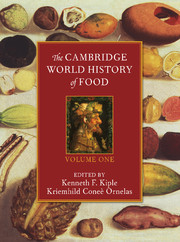Book contents
- Frontmatter
- Introduction
- Part I Determining What Our Ancestors Ate
- I.1 Dietary Reconstruction and Nutritional Assessment of Past Peoples: The Bioanthropological Record
- I.2 Paleopathological Evidence of Malnutrition
- I.3 Dietary Reconstruction As Seen in Coprolites
- I.4 Animals Used for Food in the Past: As Seen by Their Remains Excavated from Archaeological Sites
- I.5 Chemical Approaches to Dietary Representation
- I.6 History, Diet, and Hunter-Gatherers
- Part II Staple Foods: Domesticated Plants and Animals
- Part III Dietary Liquids
- Part IV The Nutrients – Deficiencies, Surfeits, and Food-Related Disorders
- References
I.1 - Dietary Reconstruction and Nutritional Assessment of Past Peoples: The Bioanthropological Record
from Part I - Determining What Our Ancestors Ate
Published online by Cambridge University Press: 28 March 2008
- Frontmatter
- Introduction
- Part I Determining What Our Ancestors Ate
- I.1 Dietary Reconstruction and Nutritional Assessment of Past Peoples: The Bioanthropological Record
- I.2 Paleopathological Evidence of Malnutrition
- I.3 Dietary Reconstruction As Seen in Coprolites
- I.4 Animals Used for Food in the Past: As Seen by Their Remains Excavated from Archaeological Sites
- I.5 Chemical Approaches to Dietary Representation
- I.6 History, Diet, and Hunter-Gatherers
- Part II Staple Foods: Domesticated Plants and Animals
- Part III Dietary Liquids
- Part IV The Nutrients – Deficiencies, Surfeits, and Food-Related Disorders
- References
Summary
The topics of diet (the foods that are eaten) and nutrition (the way that these foods are used by the body) are central to an understanding of the evolutionary journey of humankind. Virtually every major anatomical change wrought by that journey can be related in one way or another to how foods are acquired and processed by the human body. Indeed, the very fact that our humanlike ancestors had acquired a bipedal manner of walking by some five to eight million years ago is almost certainly related to how they acquired food. Although the role of diet and nutrition in human evolution has generally come under the purview of anthropology, the subject has also been of great interest to scholars in many other disciplines, including the medical and biological sciences, chemistry, economics, history, sociology, psychology, primatology, paleontology, and numerous applied fields (e. g., public health, food technology, government services). Consideration of nutriture, defined as “the state resulting from the balance between supply of nutrition on the one hand and the expenditure of the organism on the other,” can be traced back to the writings of Hippocrates and Celsus and represents an important heritage of earlier human cultures in both the Old and New Worlds (McLaren 1976, quoted in Himes 1987: 86).
The purpose of this chapter is threefold: (1) to present a brief overview of the basic characteristics of human nutriture and the history of human diet; (2) to examine specific means for reconstructing diet from analysis of human skeletal remains; and (3) to review how the quality of nutrition has been assessed in past populations using evidence garnered by many researchers from paleopathological and skeletal studies and from observations of living human beings. (See also Wing and Brown 1979; Huss-Ashmore, Goodman, and Armelagos 1982; Goodman, Martin, et al. 1984; Martin, Goodman, and Armelagos 1985; Ortner and Putschar 1985; Larsen 1987; Cohen 1989; Stuart-Macadam 1989. For a review of experimental evidence and its implications for humans, see Stewart 1975.) Important developments regarding nutrition in living humans are presented in a number of monographic series, including World Review of Nutrition and Dietetics, Annual Review of Nutrition, Nutrition Reviews, and Current Topics in Nutrition and Disease.
- Type
- Chapter
- Information
- The Cambridge World History of Food , pp. 13 - 34Publisher: Cambridge University PressPrint publication year: 2000
References
- 14
- Cited by

